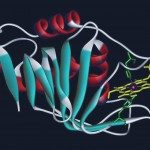Lien vers Pubmed [PMID] – 15968075
J. Bacteriol. 2005 Jul;187(13):4637-45
The Serratia marcescens hemophore-specific outer membrane receptor HasR is a member of the TonB-dependent family of autoregulated receptors. It can transport either heme itself or heme bound to the hemophore HasA. On the basis of sequence and functional similarities with other TonB-dependent outer membrane receptors whose three-dimensional structures have been determined, a HasR structure model was proposed. The mature HasR protein comprises a 99-residue amino-terminal extension necessary for hasR transcription, followed by a plug domain of 139 amino acids and a beta-barrel domain inserted in the outer membrane, the lumen of which is closed by the plug. This model was used to generate hasR deletions encoding HasR proteins with the native signal peptides but lacking either the N-terminal regulatory extension or encoding the plug or the beta-barrel alone. The protein lacking the N-terminal extension, HasR delta11-91, was incorporated in the outer membrane and was fully functional for active uptake of free and hemophore-bound heme. The HasR beta-barrel, delta11-192, was also incorporated in the outer membrane and bound the hemophore but expressed no active heme transport properties. The HasR plug remained in the periplasm. Coexpression of the plug and the beta-barrel allowed partial plug insertion in the outer membrane, demonstrating that these two HasR domains interact in vivo. The beta-barrel and the plug also interact in vitro. Nevertheless, the two domains did not complement each other to reconstitute an active TonB-dependent receptor for free or hemophore-bound heme uptake. Production of the beta-barrel alone selectively increased passive diffusion of heme but not of other exogenous compounds. A mutation at histidine 603, which is required for heme uptake through the wild-type receptor, abolished heme diffusion, showing that HasR delta11-192 forms a specific heme channel.

